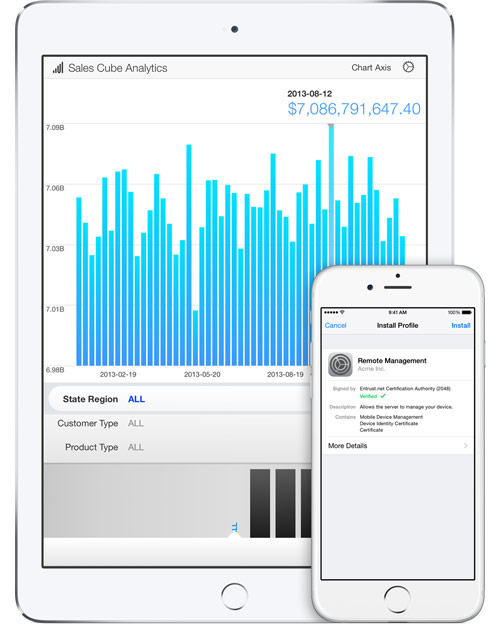Anatomy of an Apple-powered enterprise
2016 will see a battle royale ensuing between tech giants, for the top spot in enterprise management. Aside from large scale corporate operations, small and medium-size businesses are a prime target for both Apple and Microsoft, and the stakes are expected to get higher as early as this Fall, when business offerings, both in terms of devices and applications, from both Microsoft and Apple, will be in full swing.

Apple in Business
In this post we’ll talk about how a business is expected to take full advantage of Apple devices and applications, from internal management, to customer relations, in five categories:
- Device deployment/Management
- Upgrade/Update path
- Workflow
- Security
- BYOD
Device Deployment and management
Apple allows enterprises to deploy iPhone, MacBook and iPad devices within their organization, with streamlined methods where members of the organization can have their devices set up automatically, with additional streamlined customization of setup processes, including screen-ID, passcode, and terms of service.
“Zero Touch Configuration”, is described by Apple as a method where “...large-scale deployments of iPad, iPhone, and Mac are seamless...”. Mobile Device Management, or “MDM”, is completely automated, including account settings, apps, and corporate service access, without the need for additional IT support from on-site personnel.
With “Wireless supervision”, Apple gives granular control over company-issued devices, where different levels of device management can be set, by restricting access to certain apps or messaging services.
Upgrade/Update path
The typical upgrade/update scenario involves two components.
The first is an enterprise apps store, currently powered by both Apple and IBM, which cannot be accessed by regular users outside of an organization. This outlet provides business users with access to specialized apps that cover the full spectrum of internal management and customer relations.
The second aspect is the granular control over which devices are updated first, to make sure that any update or upgrade task does not interfere with regular workflow.
Workflow
Speaking of workflow, devices provided to all members of an organization can access the company VPN, and any number of dedicated apps. Unless specific restrictions have been put in place for certain devices, the same services available to regular users, such as AirDrop, AirPlay and Handoff, will be available to all company employees as well.
Security
While similar security provisions exist between regular users and enterprise, special enhancements have been made in regard to enterprise applications, that are built into the security layer of the Apps Store for business. This security layer provides ways to control, monitor and prevent unauthorized access to company data.
For instance, if an employee leaves the company, or his/her device is stolen or lost, those devices can be remotely wiped.
BYOD
Bring Your Own Device has been a hot-button issue for a long time, until recent events brought a greater level of attention to the issue of the security of an organization’s data, when accessed by devices that have not been issued by that organization. The same security measures in place for company-issued devices can also apply to devices provided by employees. These devices can also be included into the company’s private data network, with redundancies that allow that access to be managed and revoked remotely, should a device become compromised, lost or stolen.
The future of an Apple-powered enterprise
With the imminent release of iOS 9 and Mac OS X El Capitan, Apple is working on providing both users and business customers, with features and services that are designed to maximize productivity and optimize workflow, as well as providing support for a number of legacy devices, which is an attractive options to small businesses, looking to take full advantage of the devices they have already invested in, for their organization, such as iPads and iPhones used as points of sale for credit card processing at retail level, and Apple Pay-ready devices that take full advantage of Apple’s built-in security layer, designed to ensure the safety of transactions.
If you are planning on taking advantage of Apple and IBM’s business apps and services for your enterprise, our experts at Portable One can help you choose the right device from Apple’s complete range of products and accessories. Feel free to contact us at 800-650-4006 with any question you may have!